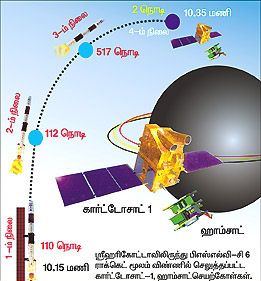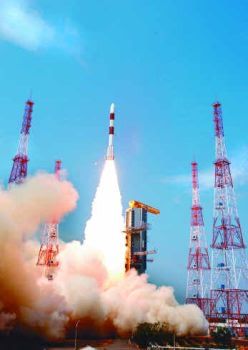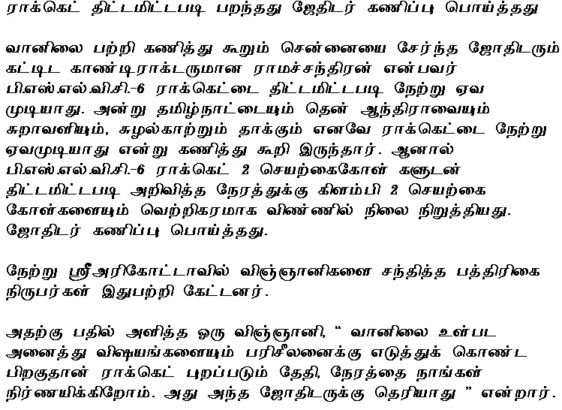பறந்தது CARTOSAT-1; பொய்த்தது ஜோஸ்யம் !



SRIHARIKOTA:
India's Polar Satellite Launch Vehicle, PSLV-C6, rose majestically from the spaceport at Sriharikota in Andhra Pradesh. It injected two satellites, CARTOSAT-1 and HAMSAT, precisely into their orbits. The lift-off was at 10.15 a.m., four minutes ahead of schedule, on May 5. PSLV-C6 put the 1,560-kg CARTOSAT-1 into orbit at a height of 627 km, 1,058 seconds after lift-off. A minute later, it slotted the micro-satellite HAMSAT, weighing 43 kg, into a similar orbit.
As the vehicle shot off like an arrow from the newly built second launch pad (SLP) at the Satish Dhawan Space Centre, a deep rumble filled the island. It was a spectacular sight — the vehicle took a parabolic path on flame and smoke, and the first of its four stages peeled away 112 seconds after ignition.
A special in many ways
The flight was special in several ways. This is the first launch from the world-class SLP. The lift-off was smooth, validating the pad's nascent systems. ``We never felt that it was taking place from the second launch pad. It was precise,'' exulted B.N. Suresh, Director of the Vikram Sarabhai Space Centre, Thiruvananthapuram. Secondly, the rocket stood on the launch pad for five days from April 30, exposed to rain, thunder, and lightning. But the rain-proof and lightning-proof vehicle stood the test well, demonstrating what a dependable workhorse it is for the Indian Space Research Organisation.
Thirdly, this was the eighth successful PSLV flight in a row. Fourthly, CARTOSAT-1, at 1,560 kg, is the heaviest remote-sensing satellite to be orbited by a PSLV. In its first successful attempt in 1994, it deployed a satellite weighing 904 kg.
The mission was witnessed by a special visitor, President A.P.J. Abdul Kalam. He watched the flight from the glass-partitioned VIP cabin at the Mission Control Centre (MCC), the nerve-centre of the launch activities. Mr. Kalam, a rocket engineer, was the project director of ISRO's first two SLV-3 flights from Sriharikota in August 1979 and July 1980. As applause filled the air when the two satellites went into orbit, the President beamed, strode briskly into the MCC proper, and hugged G. Madhavan Nair, Chairman of ISRO.
In a brief speech, he congratulated the ISRO engineers and scientists at the MCC on their ``excellent performance,'' adding, ``I am proud of you and the country is proud of you.'' He reminisced about his ISRO days and the first successful flight of the SLV-3 on July 18, 1980. ``I was on the other side'' of the MCC that day, he recalled. That flight put a 40-kg Rohini satellite into orbit. President Kalam noted that 25 years after the event, PSLV-C6 was able to put either a 1,600-kg satellite into a polar sun-synchronous orbit or a 4,000-kg satellite into a low-earth orbit at a height of 300 km to 400 km.
The ISRO Chairman noted that the vehicle traced ``a fantastically accurate trajectory.'' He added that ``we were working against all odds.'' P.S. Goel, Director of the ISRO Satellite Centre, Bangalore, which built both satellites, said CARTOSAT-1's solar panels had deployed and its health was good. While imagery from CARTOSAT-1 would be used for making maps, planning towns and so on, HAMSAT's transponders would be used for radio communication during emergencies such as cyclones, floods, and tsunamis.



